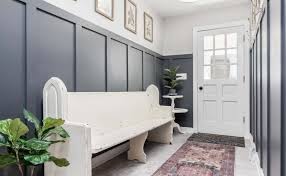The hallway is often the first area people notice when entering a home. It sets the tone for the rest of the interiors, reflecting personality and design choices. However, hallways are sometimes overlooked and left plain or under-decorated. One of the most effective ways to enhance this space is by adding panelling. hallway panellingnot only brings charm and character but also introduces texture, style, and depth that can completely transform the entryway experience.
Why Choose Panelling for Hallways
Panelling has become a popular interior design feature because it offers a timeless appeal while being highly versatile. In hallways, panelling serves both functional and decorative purposes. It can protect walls from scuffs and marks, especially in high-traffic areas, while at the same time elevating the overall design. The addition of panelling creates dimension, breaking the monotony of plain walls and turning a simple hallway into a stylish focal point.
Adding Style through Design Choices
The beauty of hallway panelling lies in its variety of styles and finishes. From classic wainscoting to sleek modern slats, the choice depends on the desired look. For traditional interiors, raised or shaker-style panels can create a sophisticated and elegant feel. In contrast, vertical or ribbed panelling works well in modern or minimalist spaces, offering clean lines and a contemporary edge.
Painted panelling can also play a significant role in styling. Dark shades such as navy or charcoal bring drama and elegance, while light tones like soft grey or cream maintain a fresh and airy feel. Pairing bold panelling colors with contrasting wall paint above can make the entryway appear striking and memorable.
Creating Texture for Visual Interest
One of the biggest advantages of hallway panelling is its ability to introduce texture. Flat walls often look dull, but panels add layers and definition that catch the eye. Whether opting for wooden finishes, tongue-and-groove boards, or geometric panel designs, the added surface variation brings warmth and sophistication. Texture also contributes to how light plays across the walls, creating subtle shadows and enhancing the hallway’s overall ambiance.
For those who prefer subtlety, half-wall panelling can add just enough texture without overwhelming the space. On the other hand, full-height panelling makes a bold statement and can elongate the appearance of the walls, giving the entryway a sense of grandeur.
Enhancing Depth and Space Perception
Hallways are often narrow or compact, and panelling can cleverly alter how the space feels. Vertical panels draw the eye upward, creating an illusion of height and making the hallway seem taller. Horizontal panels, on the other hand, widen the visual space, making narrow corridors appear broader.
Panelling also works well with mirrors and lighting, two key elements that further enhance depth. Installing a mirror above a panelled section not only reflects light but also amplifies the texture of the design. Similarly, wall-mounted lighting fixtures can highlight the grooves and patterns in the panelling, adding dimension and richness to the hallway.
Practical Benefits of Panelling
Beyond its decorative appeal, hallway panelling provides practical advantages. In busy homes, walls can easily become marked or damaged by shoes, bags, or furniture. Panelling offers an added layer of protection, especially when installed on the lower half of the wall. Certain materials, such as MDF or hardwood, are durable and easy to clean, making them suitable for high-use spaces like entryways.
Additionally, panelling can help conceal imperfections on walls, such as uneven surfaces or minor cracks. This makes it a cost-effective way to upgrade a hallway without extensive renovation.
A Timeless Investment in Design
Hallway panelling is more than just a decorative feature; it is a long-lasting design investment. Its ability to add style, texture, and depth ensures that the entryway makes a positive impression on everyone who enters. Whether aiming for a traditional, modern, or eclectic look, panelling adapts effortlessly to suit different styles and preferences.
By combining aesthetics with practicality, panelling offers a unique opportunity to transform a hallway into a welcoming and stylish introduction to the home. With thoughtful design choices, this simple addition can completely redefine the character and atmosphere of any entryway.

